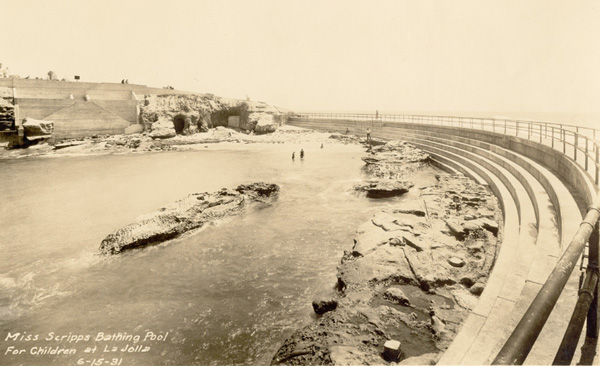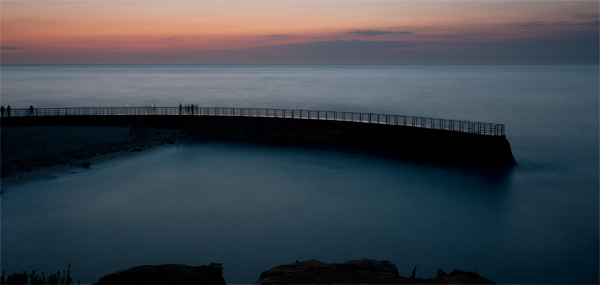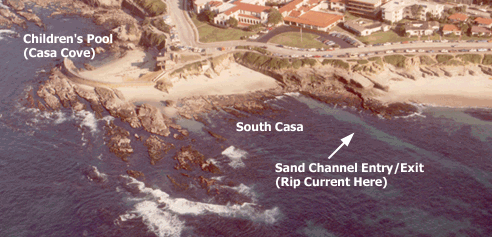South La Jolla Dive Sites

The sea wall creating Children's Pool was built by Ellen Browning Scripps in 1930-31 to provide a sheltered and safe place for children to learn to swim. It was used for that purpose, and by divers, until the mid-1990s. Children, adults, divers, and harbor seals all jointly used the water and beaches at Children's Pool and it was a lovely, pleasant place.
In 1997, more harbor seals were hauling out at Children's Pool than had previously been typical. The number of seals was high enough that the City of San Diego closed Children's Pool due to harbor seal feces contamination. With the closure of the beach to humans, the number of harbor seals skyrocketed, as did the number of activists. Sadly, the Children's Pool has been the subject of continuous legal, political, and activist activity since 1997.
In 2003, the City reopened Children's Pool under a pollution advisory (i.e., swim at your own risk). In recent years, the City has placed an advisory rope barrier on the beach at Children's Pool. The rope across the beach is advisory only and does not mean that Children's Pool is closed. You are free to cross the rope barrier, but must keep the federal Marine Mammal Protection Act in mind.
The Marine Mammal Protection Act is intended to protect the seals from harm and prohibits harassment of seals. The best approach to the MMPA is quite simple: Don't approach seals on land. Avoid silly actions like running through a field of seals on the beach. If there's an open corridor with no seals, use it to enter/exit the water so that no or very few seals "flush" into the water (leave the beach in response to you). If the beach is full of seals, dive elsewhere. Avoid any rookery between pupping and weaning of the pups (basically January to May).
Be aware that some overzealous federal agents interpret the Marine Mammal Protection Act very broadly. They like to be quoted in the newspaper saying that if you so much as make a seal raise its head to look at you, you've "harassed" the seal, violated the MMPA, and should be fined. Keep in mind that what NOAA agents tell the newspaper or claim in the field is not always the law. NOAA has lost court cases on that point and NOAA lawyers themselves argue against this standard in other cases. If you act reasonably and responsibly but still cause a small number of seals to flush into the water, and if NOAA should become aware of this and attempt to fine you, you should (a) let us know, and (b) challenge the citation. You'll likely win.
The seal activists at Children's Pool are passionate, some excessively so. They mistakenly believe that preventing the supposed seal "harassment" justifies harassing people who legally use the Children's Pool. Physical intimidation, threats, and assaults have occurred. If you should encounter one of these activists, do not respond in any way. If you are threatened, or feel threatened, call 911. The police are aware of this situation and know how to respond. In general, Children's Pool has been safe—if often unpleasant because of these activists.
While this narrative is historically accurate and has attempted to be informative, please keep in mind that NONE OF THE ABOVE IS LEGAL ADVICE.
OK, enough of all that... what about the actual diving at Children's Pool?
Children's Pool is a fabulous shallow, rocky reef dive site. Out front of the breakwall are many parallel bands of long rock ledges covered in surf grass and lots of life. Many of these rock ledges are rather tall, with fun overhangs to poke around under and see what you can find. Some of the parallel rock bands are rather close together, creating fun surge chutes you can rocket through.
Enter at Children's Pool—see all the cautions above about the seals— and use the rip current just past the end of the breakwall as a free ride out to the reefs. When coming back in, keep a close eye on the surf at the end of the breakwall, the rip, and the rock ledges out there. Stay just to the side of the rip current (which is now opposing you) but far enough from the breakwall that you don't get bashed into it, then zip around and into the calm waters of the protected pool.


With all the issues around using Children's Pool, people sometimes use South Casa instead—the other possible entrance to the wonderful shallow, rock reefs off just outside the seawall is at South Casa. South Casa is a much less easy and less safe entry/exit than is the Children's Pool, but is possible if conditions are good and you know what you're doing. To get down to the beach at South Casa, use the stairs just south of the lifeguard tower. Before you descend to the beach, however, look at the water in the small cove below you. If the water is calm enough to see the rock structure in shallow water, you will discern a sandy channel towards the left side of the cove, running parallel to the shore on the left side. If you cannot make out this channel, then maybe the surf is too high for you to use this entrance and you should go somewhere else. There is a rip which runs in this sand channel, making the entrance easy and the exit not-so-easy if there's any surf. Go out through the sand channel and turn right. Descend wherever you want. You can dive in the cove on the south side of the seawall, or you can go around in front of the seawall and do the more traditional Casa Cove dives. In front of the seawall are a series of rock reefs, in long parallel bands, running nearly parallel to shore. You won't get into water deeper than about 30' unless you go far offshore. On your return, try to go back through the sandy channel, against the rip. If there's much surf and much of a rip going, then go somewhere else next time it looks like this! If you can't get back into the channel—the surf's gotten too big and you're worried about all of the submerged rocks in the shallow water or you can't handle the rip, then you can exit on Wipeout Beach. That's the beach right in front (east) of you when you are deciding whether you can get back up the sandy channel. Wipeout Beach is a shore break. That means that there will be nasty, big waves breaking right on the beach. Don't take your fins off. Don't take your mask off. Know where your regulator is. And crawl out. This, of course, is if the conditions have seriously deteriorated. Otherwise, just go back up the sandy channel.
There are great kelp beds way off Casa Cove. They're an even longer swim from the South Casa entrance. From Children's Pool itself, it's about a 30 minute surface swim to get to the inside of the kelp beds, and about 45 minutes to get to the outside of the kelp bed. This surface swim is in the (inner) boat lane, so keep your eyes and ears open and be ready to descend if you get concerned. The kelp beds are quite beautiful, and sit in 45–60' of water or so. In places there are great, long bottom rock formations that almost look like fault lines (have no idea if they are or not). Your return compass bearing depends on where you end up in kelp beds, which can be rather variable after a 30–45 minute surface swim. Simply take a compass reading back to South Casa (or Shell Beach, if you were getting really creative) before you descend.
This is another great shallow, rock reef dive of La Jolla. Only attempt this dive at high tide and no surf. You want high tide because the entry and exit has all kinds of nasty submerged rocks in shallow water. You want no surf so that you head doesn't get bashed into said rocks. It's an exposed beach with a decent surf break, and with any swell you just don't want to be there. The exit is worse than the entrance, so don't get fooled. That said, it's a great dive. It's like Casa Cove, but better because it's less disturbed (it's a lot harder to get into the water here). Keep your eyes out for an underwater rock arch. It's best to do Hospital Point with someone who's dived there before, the entry/exit point is hard to describe. From the picnic table just north of the small building on the coast there, look down and to the right for a small section of beach just left of several long parallel cuts (channels) in the rock, running sharply out and to the left. This little section of beach has slightly fewer rocks, but they're still there.